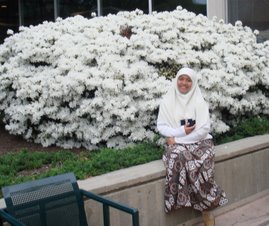What A Brilliant Dream!
A response on an article entitled The Essentials conditions for Technology Integration in Digital-Age Literacy for Teachers
When I read an article entitled An Educator's vision of the future by Annemarie Tammerman the first response I could say was only...wow... what a brilliant dream! She had clearly mentioned in details how we, educators, should be very engaged with the technology that ,whether you like it or not, has come into every single cell of our life. She has become an instructional technology consultant in North Carolina Department of Public Instruction where she had get in touch so closely to developing teacher's competence and interaction into technology. That is why she really has a detail in her vision. A vision that is really possible to be a truth. She mentioned in her article that in the year of 2026, a classroom will be videoconferencing across the United States and the teachers are tutoring of twenty students each. Students can join the seminars called the Socratic Seminars. At the same time the teachers are maintainly developed in a special professional development centers.
I wrote those response as my introduction on the Essential Conditions for Effective Integration reflection because that is exactly we need as teachers and educators to face the 21st century. Students nowadays are really the native of digital era (Marc Prensky.com.2001). So if teachers do not want to change, be open minded, and put the best efforts to dive into the digital ocean, they will be drown by the waves of technology. As it is mentioned in the article that to change the paradigma, it needs all efforts from the educational community. Not only the teachers, but also the leaders and decision-makers in educational system, wherever it is in the world. Networking and working hand-in-hand, helping each other country is the key to make a Global village, global community.
In order to change the whole system, it needs the whole parts and body of the educational system to change as it is mentioned in the Essential Conditions for Effective Integration, as follows:
Table o.1 : Essential Conditions for effective technology integration
Support Policies : School and university policies, financing, and reward structures are in place to
support technology in learning
The question now, how to encompass the challenge we face now? while on the other hand, our students have been flashing with their ability with technology. They are hypertext generation, multitasking and splitting brain community. What I mean by splitting brain is that the students now is can split their minds into different focus at the same time, and yet still connect to the recent or main focus. That is something I cannot do. Well, what can I say, I come from a digital immigrant society. I can only focus on one thing at one time. It seems that while I am studying in United States, the circumstances and the communities I get along with, make me learn to be in brain splitting (or mind splitting?).
Back to the question, Tammerman said in the article that the leaders in educations should have a vision to make an Instructional revolution to make a rapid advancement in information and communications technology.There are different roles done by the whole education community that I noted were mentioned by Tammerman. In her Instructional Revolution she dreams of, she firstly mentioned about the changing role of the teacher. The teacher play as a developmental mentor that is paired to students called cherubs to help, guide, and advising the students to choose the modules they are interested in. They are paired only until the module finishes.
The next important part is the lessons and the class done. The class is done in such interesting way, with high bandwidth videoconferencing and with attendees from different part of the states, even the different part of the world, by using the name the Socratic Seminar. It takes place in virtual design ce nter with high advanced technology, with holographic view and students are using virtual projection.
The third one is the use of Immersion methods of the Instructional strategies. It means that the instruction are integrated one to another without distinction and all subject are diluted into one single big topic contains of different shapes.
Those parts are even supported with the research life like the technology Institutes and higher education who give biggest contribution by making real life connection and latest invention to be understood not only by the college students but also the k12 students.
The last thing she mentioned is the real-life bounded lesson designed to interact and educating so that students will easily apply to their real life.
In short, I could only say that as teacher we cannot just stay in our comfort zone, teach the same thing year by year until reaching thirty years of teaching because the world has rapidly changing into digital and virtual wolrd. It is possible that someday humankind all in the world live in the same dome and share the same smile and no hatred with one to another.
I remember once a leading educator in my country, my dear teacher and my dear colleague at the same time say these words: “Teach ten lesson plans in one year but never teach one lesson plan for ten years ( more or less similar the her original words).


No comments:
Post a Comment